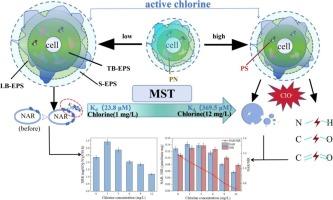活性氯对活性污泥反硝化性能的剂量依赖性:细胞外聚合物屏障的构建及酶-底物相互作用机制
IF 6.7
2区 工程技术
Q1 ENGINEERING, CHEMICAL
引用次数: 0
摘要
当回用废水补充湖泊和水库时,需要进行高级脱氮工艺,以防止富营养化的风险。然而,NaClO消毒产生的剩余活性氯对活性污泥反硝化系统的影响尚不清楚。本研究通过批处理实验,结合光谱学和微尺度热泳术(MST)研究了氯胁迫下细胞外聚合物(EPS)的防御机制和酶-底物相互作用的动力学。结果表明,低浓度的活性氯(1 ~ 3 mg/L)可触发微生物应激反应,使硝酸盐去除率(NRE)较对照组提高5.71% ~ 17.14%。值得注意的是,紧密结合的EPS内的蛋白质组分通过形成疏水屏障在抵抗氯诱导的氧化中发挥了关键作用。高氯浓度(6 ~ 12 mg/L)对EPS的关键官能团(NH、CO、CO)造成氧化损伤,破坏微生物细胞膜的完整性,导致NRE下降20.00% ~ 49.86%。MST分析首次揭示了活性氯调控酶与底物结合亲和力的机制。在低氯浓度(1 mg/L)下,硝酸还原酶(NAR)与NO3−的解离常数Kd由100.85 μM降至23.76 μM,酶的催化效率显著提高。高氯浓度(12 mg/L)下,Kd值增加至369.46 μM,表明酶失活。本研究阐明了氯消毒对活性污泥反硝化的干扰。研究结果可为中水系统高级脱氮工艺的优化提供理论基础。本文章由计算机程序翻译,如有差异,请以英文原文为准。

Dose-dependent effects of active chlorine on denitrification performance of activated sludge: Construction of extracellular polymeric substance barrier and enzyme-substrate interaction mechanism
When the reclaimed wastewater is used to replenish the lakes and reservoirs, advanced nitrogen removal process is required to prevent the risk of eutrophication. However, the impact of residual active chlorine resulting from NaClO disinfection on activated sludge denitrification systems remains unclear. In this study, the defense mechanisms of extracellular polymeric substances (EPS) and the dynamics of enzyme-substrate interactions were investigated under chlorine stress through batch experiments, combined with spectroscopy and microscale thermophoresis (MST). The results indicated that low concentrations of active chlorine (1–3 mg/L) triggered microbial stress responses, causing a 5.71 %–17.14 % increase in nitrate removal efficiency (NRE) compared to the control group. Notably, the protein components within tightly bound EPS played a key role in resisting chlorine-induced oxidation by forming a hydrophobic barrier. In contrast, high chlorine concentrations (6–12 mg/L) caused oxidative damage to key functional groups of EPS (N![]() H, C
H, C![]() O, C
O, C![]() O) and compromised the integrity of microbial cell membrane, leading to a 20.00 %–49.86 % decline in NRE. The MST analysis revealed, for the first time, the mechanism through which active chlorine regulates the enzyme-substrate binding affinity. At a low chlorine concentration (1 mg/L), the dissociation constant (Kd) of nitrate reductase (NAR) and NO3− decreased from 100.85 μM to 23.76 μM, causing a significant rise in the catalytic efficiency of enzyme. In contrast, at high chlorine concentration (12 mg/L), Kd value increased to 369.46 μM, indicating enzyme deactivation. This study clarifies how chlorine disinfection interferes with activated sludge denitrification. The findings may serve as a theoretical foundation for optimization of advanced nitrogen removal processes in reclaimed water systems.
O) and compromised the integrity of microbial cell membrane, leading to a 20.00 %–49.86 % decline in NRE. The MST analysis revealed, for the first time, the mechanism through which active chlorine regulates the enzyme-substrate binding affinity. At a low chlorine concentration (1 mg/L), the dissociation constant (Kd) of nitrate reductase (NAR) and NO3− decreased from 100.85 μM to 23.76 μM, causing a significant rise in the catalytic efficiency of enzyme. In contrast, at high chlorine concentration (12 mg/L), Kd value increased to 369.46 μM, indicating enzyme deactivation. This study clarifies how chlorine disinfection interferes with activated sludge denitrification. The findings may serve as a theoretical foundation for optimization of advanced nitrogen removal processes in reclaimed water systems.
求助全文
通过发布文献求助,成功后即可免费获取论文全文。
去求助
来源期刊

Journal of water process engineering
Biochemistry, Genetics and Molecular Biology-Biotechnology
CiteScore
10.70
自引率
8.60%
发文量
846
审稿时长
24 days
期刊介绍:
The Journal of Water Process Engineering aims to publish refereed, high-quality research papers with significant novelty and impact in all areas of the engineering of water and wastewater processing . Papers on advanced and novel treatment processes and technologies are particularly welcome. The Journal considers papers in areas such as nanotechnology and biotechnology applications in water, novel oxidation and separation processes, membrane processes (except those for desalination) , catalytic processes for the removal of water contaminants, sustainable processes, water reuse and recycling, water use and wastewater minimization, integrated/hybrid technology, process modeling of water treatment and novel treatment processes. Submissions on the subject of adsorbents, including standard measurements of adsorption kinetics and equilibrium will only be considered if there is a genuine case for novelty and contribution, for example highly novel, sustainable adsorbents and their use: papers on activated carbon-type materials derived from natural matter, or surfactant-modified clays and related minerals, would not fulfil this criterion. The Journal particularly welcomes contributions involving environmentally, economically and socially sustainable technology for water treatment, including those which are energy-efficient, with minimal or no chemical consumption, and capable of water recycling and reuse that minimizes the direct disposal of wastewater to the aquatic environment. Papers that describe novel ideas for solving issues related to water quality and availability are also welcome, as are those that show the transfer of techniques from other disciplines. The Journal will consider papers dealing with processes for various water matrices including drinking water (except desalination), domestic, urban and industrial wastewaters, in addition to their residues. It is expected that the journal will be of particular relevance to chemical and process engineers working in the field. The Journal welcomes Full Text papers, Short Communications, State-of-the-Art Reviews and Letters to Editors and Case Studies
 求助内容:
求助内容: 应助结果提醒方式:
应助结果提醒方式:


